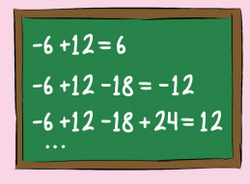4- The Sequence
 The sequence -6, 12, -18, 24, -30, 36, ... is obtained from the positive multiples of 6, the terms multiplying by -1 in the odd positions. Note in the figure that the sum of the first two terms of the sequence is equal to 6 and the sum of the first three terms is equal to -12. How many consecutive terms of this sequence we must add, from the first, to get 180 as a result?
The sequence -6, 12, -18, 24, -30, 36, ... is obtained from the positive multiples of 6, the terms multiplying by -1 in the odd positions. Note in the figure that the sum of the first two terms of the sequence is equal to 6 and the sum of the first three terms is equal to -12. How many consecutive terms of this sequence we must add, from the first, to get 180 as a result?
The answer is 60.
This section requires Javascript.
You are seeing this because something didn't load right. We suggest you, (a) try
refreshing the page, (b) enabling javascript if it is disabled on your browser and,
finally, (c)
loading the
non-javascript version of this page
. We're sorry about the hassle.
We must look at the results of the sums. They form the following sequence: -6,6,-12,12,-18,18,-24,24,..... So we can say that we have 2 arithmetic progressions: 6,12,18,24,.... and -6,-12,-18,-24,... Taking one of them and appliyng the general term formula of an AP, we have: a n = a 1 + ( n − 1 ) . r ; 1 8 0 = 6 + ( n − 1 ) . 6 ; n = 3 0 ; But we have to double this result, since we also have the negative numbers. So, the answer is 60.